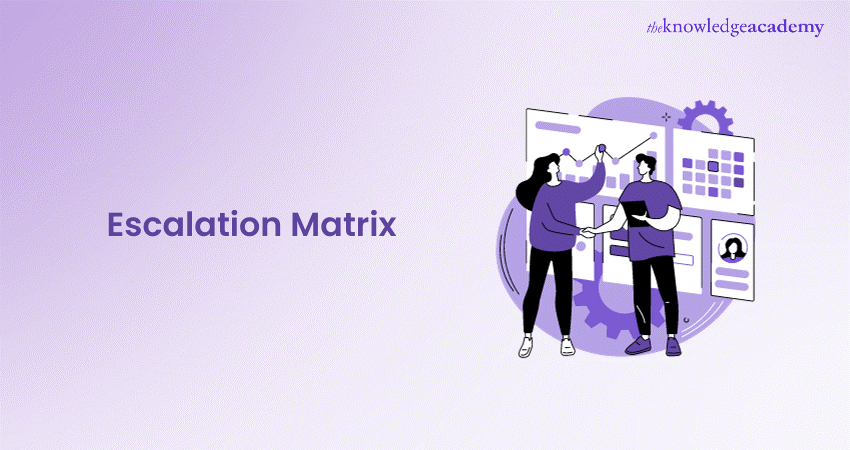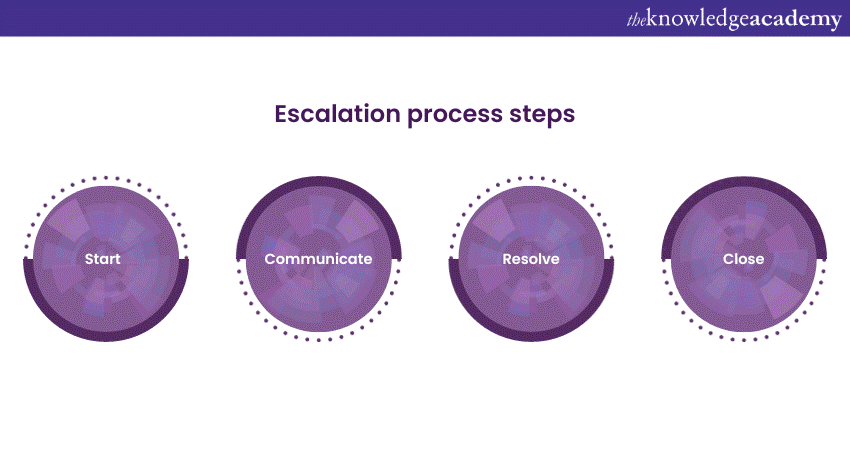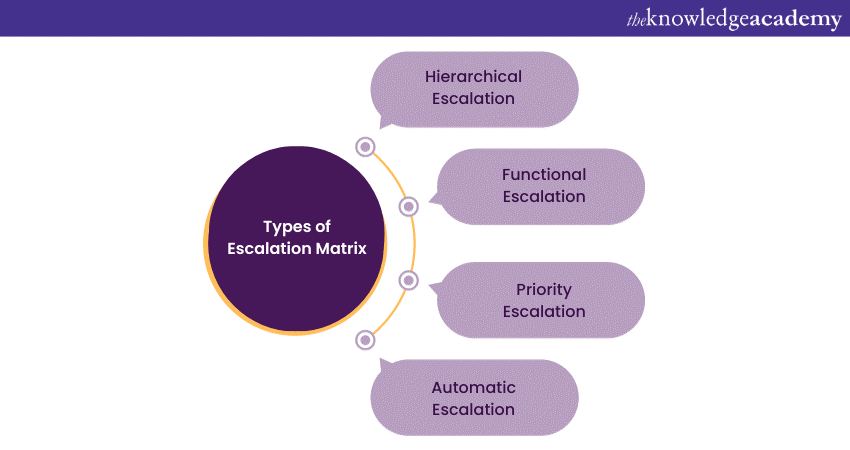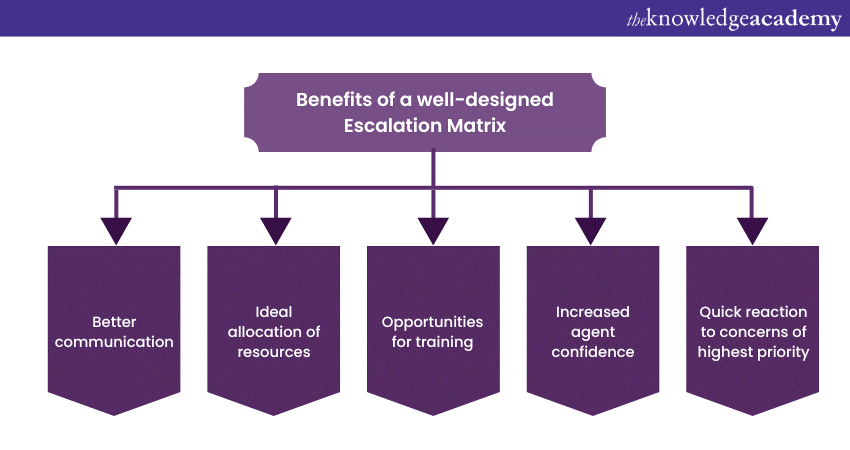We may not have the course you’re looking for. If you enquire or give us a call on 01344203999 and speak to our training experts, we may still be able to help with your training requirements.
Training Outcomes Within Your Budget!
We ensure quality, budget-alignment, and timely delivery by our expert instructors.

An Escalation Matrix is a set of predefined procedures within an organisation that outline the process of Escalating issues to higher authority for resolution. It delineates the hierarchical Escalation tiers and designates the individuals or teams accountable for managing incidents within each tier. The level of detail within escalation matrices can vary among different organisations.
While some matrices may adopt a hierarchical structure, others may be tailored to specific situations, delineating distinct sets of contacts for various types of incidents or levels of severity. The primary objective of an Escalation Matrix is to guarantee the swift and effective resolution of issues. It offers a well-defined route for elevating concerns, spanning a range of areas, including human resources, customer service, and technical issues.
Table of Contents
1) What is an Escalation Matrix?
2) Importance of Escalation Matrix
3) Escalation process steps
4) Types of Escalation Matrix
5 Benefits of a well-designed Escalation Matrix
6) Best practices to handle Escalation Management
7) Conclusion
What is an Escalation Matrix?
An Escalation Matrix is a valuable tool utilised by businesses to manage the process of Escalation effectively. This tool can be applied across various departments within a company, including sales and marketing teams. The objective of implementing a project Escalation Matrix is to monitor all challenges that arise in operations systematically and to document the corresponding solutions.
This approach allows for a clear understanding of the status of each issue at any given moment. Such comprehensive insights aid in the decision-making process, enabling teams and organisations to identify problems. This Escalation Matrix template can serve to keep tabs on the volume of reported issues, their degree of severity, and whether they have been successfully resolved or remain outstanding.

Importance of Escalation Matrix
The importance of an Escalation Matrix cannot be overstated, as it plays a pivotal role in offering a meticulously structured framework for effectively tackling issues. Adherence to the Escalation Matrix is essential for establishing a systematic and trustworthy approach to managing and resolving problems.
The significance of the Escalation Matrix becomes even clearer when we break down its importance into the following key elements:
a) Consistency: The utilisation of an Escalation Matrix ensures a uniform and systematic process for handling issues, irrespective of the individuals involved. This consistency not only enhances the predictability of the process but also ensures that each issue receives the attention it deserves.
b) Efficiency: Clearly defined Escalation routes, along with their associated responsibilities, serve to streamline the process. By doing so, delays are minimised, and misunderstandings are mitigated. This ensures that issues are channelled swiftly to the appropriate level of expertise where they can be addressed effectively.
c) Accountability: An Escalation Matrix serves as a clear blueprint for delineating the responsibilities of each person or department involved in the process. This delineation establishes a sense of accountability, where individuals or teams are aware of their roles and duties. Consequently, the result is prompt and effective issue resolution, as there is clarity about who is responsible for what.
d) Customer satisfaction: Adherence to an Escalation Matrix has a direct impact on customer satisfaction. By adhering to a structured process, organisations can provide their customers with a transparent and efficient pathway for addressing complaints or concerns. This transparency instils confidence in customers that their issues will be taken seriously and resolved promptly.
e) Risk management: The utility of an Escalation Matrix is not limited to issue resolution but extends to risk management. By addressing issues at the appropriate juncture, the Matrix helps in the early mitigation of risks. It allows problems to be dealt with promptly, preventing them from evolving into more severe and complicated problems.
How should you create an Escalation Matrix?
Depending on your organisation's structure and needs, map out the hierarchy or functional departments involved in the Escalation process. Clearly define who is responsible for addressing specific types of issues and when they should be engaged. Establish clear protocols that outline step-by-step procedures, roles, and responsibilities.
Communication channels are a vital component of your Escalation Matrix, so ensure that there are efficient methods for submitting Escalation issues, whether through dedicated email addresses, software systems, or escalation request forms. Educate your team about the Matrix through training sessions and effective communication to ensure everyone understands its significance and how to follow it.
Regular monitoring and updates are essential to keep the Matrix relevant and effective. Review the Matrix regularly to track issue resolutions and identify any bottlenecks or areas for improvement. Test the Escalation process with pilot tests before full implementation, and create a comprehensive document outlining the Matrix's structure, triggers, and procedures for easy reference.
Incorporate feedback mechanisms to gather insights from users and refine the Matrix over time. Regularly review and improve the Escalation Matrix as needed, as it should be a dynamic tool that evolves with your organisation's changing requirements. By following these steps, you can develop a robust Escalation Matrix that streamlines issue resolution, enhances communication, and contributes to your organisation's overall success.
Get your ITIL® Certification Training and create a great opportunity for career advancement
Escalation process steps
The effective management of Escalation demands a structured and well-defined procedure to ensure that issues are addressed systematically and efficiently. The critical steps in this process can be broken down as follows:

1) Start
The process begins with the initiation of the Escalation based on predetermined criteria. These criteria can encompass various factors, including financial considerations, the involvement of personnel, technical attributes, or specific functionality requirements. It is imperative to include all relevant details, such as identifying the affected customers, delineating the impacted services, referencing associated records, and providing essential contact information.
2) Communicate
Timely and clear communication is the lifeblood of the Escalation process. Within the initial hour of the Escalation, it is essential to notify internal stakeholders and affected customers about its commencement. To maintain a transparent and informed process, a continuous flow of updates is crucial. Developing a comprehensive action plan is pivotal, and this plan should be informed by the information contained within the Escalation record.
3) Resolve
The resolution stage necessitates adaptability and a readiness to respond to new information and insights from subject matter experts. Mobilising a dedicated task force is often required to address the technical event and devise a detailed plan for resolution. Officially declaring the resolution is the culmination of this stage, and this resolution should be communicated to both internal and external parties. Ensuring that impacted customers regain access to any disrupted services is an integral part of this step.
4) Close
The conclusion of the Escalation process involves several critical actions. Validation is necessary to confirm the resolution of any issues reported by customers. Requesting a Root Cause Analysis (RCA) is crucial to uncover the fundamental cause behind the problem. Creating an internal RCA based on the information contained in the problem record is vital for internal learning and process improvement. Sharing a final RCA with the customers affected by the Escalation ensures transparency and underscores the organisation's commitment to addressing and learning from the issue.
Acquire skills in applying the key concepts of ITAM capability development with our ITIL ® 4 Specialist: IT Asset Management Training and stay ahead of the learning curve!
Types of Escalation Matrix
The following are the types of Escalation Matrix:

1) Hierarchical Escalation
The most prevalent form of Escalation is the hierarchical approach. Under this method, a support ticket is escalated to a team, or an individual based on their seniority and extensive experience in dealing with similar issues. For example, a supervisor may choose to Escalate the problem to an account manager, who, in turn, might further Escalate the unresolved issue to the head of the sales department.
2) Functional Escalation
Functional Escalation involves directing a ticket to the team or individual possessing the precise skill set necessary to resolve critical issues, even if they do not hold the next hierarchical position. For example, if customer inquiries pertain to an upcoming payment, the accounts and billing department, despite not being the next hierarchical level, would be best equipped to handle them.
3) Priority Escalation
In this approach, issues are Escalated based on their priority, resulting in faster routing to team leaders and higher-level personnel due to their increased significance. For example, an Information Technology problem causing frequent phone echoing would be assigned a higher priority than investigating a supply delivery that is just one day late. The identification of high-priority issues is essential to ensure the appropriate support team promptly addresses them.
4) Automatic Escalation
In this scenario, businesses make use of call centre software to automatically route project-related issues to the next level when a certain amount of time passes without a resolution. This automated process streamlines the Escalation procedure, ensuring timely attention to problems that remain unresolved.
Benefits of a well-designed Escalation Matrix
Implementing an efficient Escalation Matrix is not only a structured approach to issue management but also offers a range of additional advantages, each contributing to the overall improvement of an organisation's operations:

1) Better communication
Well-structured Escalation guidelines serve as a robust platform for promoting enhanced communication within an organisation. By adhering to these guidelines, agents are empowered to provide comprehensive information when transferring incidents to their respective counterparts. This clarity and transparency in communication lead to a seamless exchange of information and a deeper understanding of the situation by all involved parties. Consequently, miscommunication and misunderstandings are minimised, leading to more effective issue resolution.
2) Ideal allocation of resources
Efficient resource allocation is a critical element in the successful management of issues. An Escalation Matrix ensures that incidents are directed to the most qualified individuals or teams, matching the specific skills and expertise required to resolve the problem. This targeted approach not only expedites the resolution process but also ensures that issues are resolved within the defined Service Level Agreement (SLA). This, in turn, optimises resource utilisation, ensuring that the right people are deployed to address problems in a timely and effective manner.
3) Opportunities for training
Escalation processes are not just mechanisms for issue resolution; they also serve as invaluable training resources. This is especially pertinent for remote agents or those new to the organisation. The structured approach of an Escalation Matrix provides an excellent opportunity for agents to learn and develop their skills in handling challenging situations proficiently. It allows them to gain practical experience, enabling them to become more adept at managing critical issues as they arise.
4) Increased agent confidence
Clear and precisely defined Escalation guidelines have an additional, often underestimated, benefit in terms of agent morale and confidence. When agents are armed with a well-structured Matrix, it alleviates their apprehensions. They can approach their tasks with confidence, knowing that there is a structured process to follow. This sense of security allows agents to concentrate on fulfilling customer requests and engaging in more constructive conversations with customers, ultimately improving the overall quality of customer interactions.
5) Quick reaction to concerns of highest priority
One of the most significant advantages of an Escalation Matrix is its ability to expedite the handling of high-priority issues. Critical problems can be rapidly identified and Escalated to the appropriate personnel or teams. This streamlined process ensures the prompt notification of employees regarding these crucial matters, guaranteeing that they receive immediate attention and resolution. This not only satisfies customer expectations but also contributes to the overall efficiency and effectiveness of the organisation.
When to Escalate a problem?
When an employee or manager has attempted multiple times to de-escalate a problem independently but cannot achieve a resolution on the initial contact, it becomes necessary to commence the process of Escalating the issue.
Ensure that comprehensive documentation of the problem exists, along with records of the efforts made to resolve it. This documentation should encompass pertinent emails, precise timestamps for phone calls, instances of missed deadlines, Human Resources reports, and any customer complaints received.
Several common factors and situations that prompt the need for Escalation and incident management include:
a) Need for satisfied customers.
b) Violations of Service Level Agreements (SLAs).
c) Inadequate employee expertise or insufficient training to effectively assist a customer.
d) Specific requests from customers to speak with a supervisor or manager.
e) Abrupt surges in call volume during peak hours.
f) To prevent prolonged customer hold times.
g) Task dependencies hinder project progress.
h) Need for more authority within the Project Management Office (PMO) to deliver a solution.
i) Continued delays could lead to missed deadlines, reduced sales, or customer loss.
j) Projects nearing or exceeding budget constraints.
k) A lack of response within the stipulated time frame.
Initiating the Escalation process in such cases helps address issues effectively and ensures the best possible outcomes for both customers and the organisation.
Understand problem identification techniques to mitigate service disruptions with ITIL® Practitioner: Problem Management Training and enhance service quality
Best practices to handle Escalation Management
Remembering to establish comprehensive and documented Escalation procedures can result in clarity and unnecessary delays. It's essential to articulate clear steps, assign responsible parties, set timeframes, and define communication channels for each Escalation level.
To prevent mishaps, it's vital to ensure that all involved stakeholders receive adequate training. They should be well-versed in their roles and responsibilities within the Escalation process. Maintaining regular communication and providing updates are equally crucial to keep everyone informed and prepared.
Effective communication is pivotal for the smooth functioning of the Escalation process. Sufficiently clear and accessible communication channels must be maintained. Stakeholders should be promptly informed about Escalations, updates, and resolutions. This proactive approach also helps in mitigating potential misunderstandings.
Keeping tabs on Escalations is essential to ensure timely resolution and accountability. Implementing a system or tool for recording Escalation details, response times, and solutions is recommended. This practice enables thorough analysis and facilitates continuous improvement in the Escalation management process.
Gain knowledge of IT services and the responsibilities of an IT Service Manager with our Certified IT Service Manager CITSM Course
Conclusion
In conclusion, the adoption of an Escalation Matrix represents a step towards augmenting operational efficiency and transparency within organisations. This not only clears the pathways of task progression but also serves as a spotlight on potential obstacles and areas for enhancement. It helps in contributing to the overall effectiveness and performance of the organisation.
Learn about the core service management activities involved in the ITIL with ITIL® Specialist: Create, Deliver And Support CDS Course and stay ahead of the learning curve!
Frequently Asked Questions
Upcoming IT Service Management Resources Batches & Dates
Date
 ITIL® 4 Foundation Certification Course
ITIL® 4 Foundation Certification Course
Tue 7th May 2024
Thu 9th May 2024
Mon 13th May 2024
Wed 15th May 2024
Sat 18th May 2024
Mon 20th May 2024
Wed 22nd May 2024
Tue 28th May 2024
Thu 30th May 2024
Mon 3rd Jun 2024
Wed 5th Jun 2024
Mon 10th Jun 2024
Wed 12th Jun 2024
Sat 15th Jun 2024
Mon 17th Jun 2024
Wed 19th Jun 2024
Mon 24th Jun 2024
Wed 26th Jun 2024
Sat 29th Jun 2024
Mon 1st Jul 2024
Wed 3rd Jul 2024
Mon 8th Jul 2024
Wed 10th Jul 2024
Sat 13th Jul 2024
Mon 15th Jul 2024
Wed 17th Jul 2024
Mon 22nd Jul 2024
Wed 24th Jul 2024
Sat 27th Jul 2024
Mon 29th Jul 2024
Wed 31st Jul 2024
Mon 5th Aug 2024
Wed 7th Aug 2024
Sat 10th Aug 2024
Mon 12th Aug 2024
Wed 14th Aug 2024
Mon 19th Aug 2024
Wed 21st Aug 2024
Sat 24th Aug 2024
Tue 27th Aug 2024
Thu 29th Aug 2024
Mon 2nd Sep 2024
Wed 4th Sep 2024
Sat 7th Sep 2024
Mon 9th Sep 2024
Wed 11th Sep 2024
Mon 16th Sep 2024
Wed 18th Sep 2024
Sat 21st Sep 2024
Mon 23rd Sep 2024
Wed 25th Sep 2024
Mon 30th Sep 2024
Wed 2nd Oct 2024
Sat 5th Oct 2024
Mon 7th Oct 2024
Wed 9th Oct 2024
Mon 14th Oct 2024
Wed 16th Oct 2024
Sat 19th Oct 2024
Mon 21st Oct 2024
Wed 23rd Oct 2024
Mon 28th Oct 2024
Wed 30th Oct 2024
Sat 2nd Nov 2024
Mon 4th Nov 2024
Wed 6th Nov 2024
Mon 11th Nov 2024
Wed 13th Nov 2024
Sat 16th Nov 2024
Mon 18th Nov 2024
Wed 20th Nov 2024
Mon 25th Nov 2024
Wed 27th Nov 2024
Sat 30th Nov 2024
Mon 2nd Dec 2024
Wed 4th Dec 2024
Mon 9th Dec 2024
Wed 11th Dec 2024
Sat 14th Dec 2024
Mon 16th Dec 2024
Wed 18th Dec 2024







 Top Rated Course
Top Rated Course


 If you wish to make any changes to your course, please
If you wish to make any changes to your course, please


